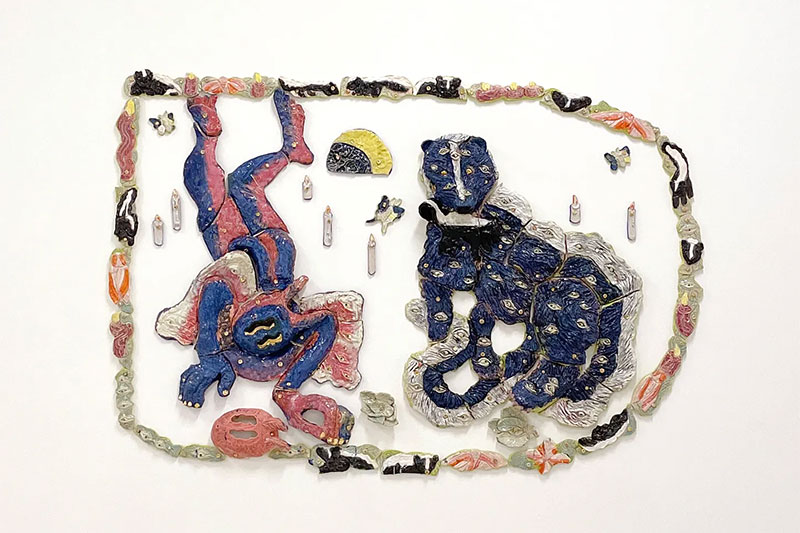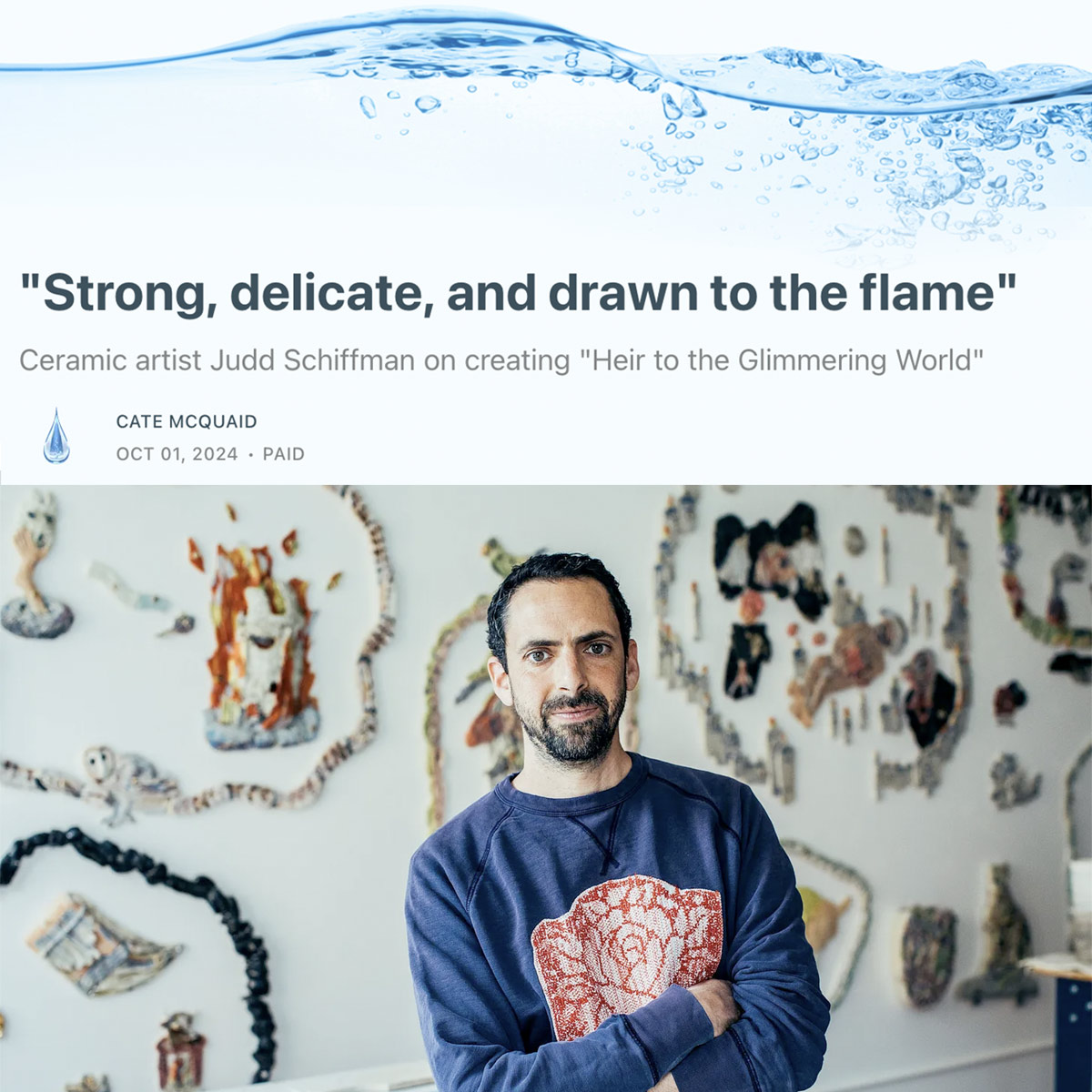“Strong, delicate, and drawn to the flame”
Ceramic artist Judd Schiffman on creating “Heir to the Glimmering World”
by Cate McQuaid
October 1, 2024
Above: Judd Schiffman. Photo Sasha Israel.
I first saw Judd Schiffman’s work at ODD-KIN a year ago – an ambitious narrative wall installation of tiles depicting Mothman, a moth-like humanoid first seen in West Virginia in 1966. “The Self That Touches All Edges” shows the cryptid embracing a tree with eyes. The piece suggests a tenderness for life in the face of our fleeting minutes and a changing biosphere. The artist has work in a local exhibition, Encircled, right now at Drive-By Projects. His solo show, “Mothman in the Bardo”, runs at Emerson Dorsch gallery in Miami through Nov. 2.
I took Mothman to be an avatar for us humans, and perhaps for the artist himself. Reading what he writes about his creative process, I can see how he would identify with such a creature; his work itself is an amalgam of nature, the mythic dimension, and the soulfulness of knowing life’s richness and brevity. Judd’s work seems to say: Our time is over in a flash, and yet everything we have lived so far colors and shapes the present moment. Eternity is a river where all experience collects. It moves, yet we will always find it in the same place – but deeper, if we look.
“Sometimes I have a dream or an experience, and it takes a couple of years to come out in my ceramic work,” Judd writes. “The framed pieces at Drive-By Projects are an amalgamation of different experiences 20 or 30 years old. Backpacking in the Southwest, going to a funeral in Zimbabwe, and meeting with a therapist in Providence. The works help me to understand vibrant experiences and create a map of them. I think about all these things and make drawings,” which lead to his sculptures.
Here, he details the creation of a Mothman work in the Emerson Dorsch show, “Heir to the Glimmering World.”
Judd writes:
I mostly make ceramic wall relief sculpture; my works are composites of multiple experiences but are pushing forward a singular idea. In “Heir to the Glimmering World,” the idea is that life has a rhythm, and is synchronistic as things are born, live, and die. As the skunk mother tends to its young, Mothman is pondering his own mortality. The frame consists of moths, candles and skunks, suggesting a ritual.

I’m involved with building of worlds, taking things from dreams, meditation, fiction novels, art history, lots of Buddhist and sometimes Jewish ideas, my own life experience related to nature, and mixing them together. I am fascinated with the power of the natural world and I think that comes through in the work. I am fascinated by our human cycles of emotion, thought, and growth. I love how writers can capture this in a book, or a poem, and often a title, sentence or phrase drives the concept behind the work.

“Heir to the Glimmering World” is a novel by Cynthia Ozick, about a family that emigrated to the United States from Germany during World War II, just as things were starting to turn nightmarish. My grandmother had a similar trajectory from Poland – maybe that is why I was drawn to the book. The title appeals to me because it suggests that we are alive for a short period, and we inherited the world in all its beauty and terror.
This concept can be taken further through a Buddhist lens: Our inherited lives are temporary, and we will all die at some point. I don’t think this statement is sinister, it’s very pragmatic, and it can be joyful to reflect on the temporary nature of things. Everything is so vibrant and transient, like autumn leaves. I love this quote by the buddhist teacher Chögyam Trungpa:
“Look. This is your world! You can’t not look. There is no other world. This is your world; it is your feast. You inherited this; you inherited these eyeballs; you inherited this world of color. Look at the greatness of the whole thing. Look! Don’t hesitate – look! Open your eyes. Don’t blink, and look, look – look further.”

This quote is the backbone of “Heir.” There are other experiences that informed the concept. Seeing a skunk carrying a baby in its mouth while driving down the street with my wife astonished me. The skunk’s body in “Heir” is covered with eyes; it’s all-knowing and selfless. Mothman is a character I have been working with for a few years. He is strong, delicate, and drawn to the flame. He is contemplating his own death, and the mask of his identity.

“Heir” is the biggest ceramic wall sculpture I have made and I am happy with it. I hope it communicates on some level the things I am describing. It is installed in Miami right now as part of a solo show at Emerson Dorsch gallery, which has several sculptures illustrating cycles of life and death as described in various Tibetan Buddhist teachings.
Thinking about all these ideas, I make a lot of drawings of various sizes, using ink, brushes, and calligraphy pens. I copy the figures and gestures of old painters. I roll out a bunch of clay slabs and smack them against the wall together. It’s nice when the sculpture is about my height as it is with “Heir.”
I draw on it, and build it up with coils, and then create texture, and draw on it more. This part usually takes about a week. There is a mysterious communication happening between me, my ideas, and the material at this stage. Then I cut it into pieces and lay it out on the floor and keep working, drawing, carving, polishing. This usually takes about a week as well. Everything needs to dry slowly and carefully for a couple more weeks.

I put the dry tiles into bins and drive them over to Providence College to use their kilns. I lay it all out again. Sand it. And then load everything into the kiln. The firing takes about 12 hours, and then 12 more hours to cool. I take everything out and install it on the wall. Wipe the dust off and spend a few days glazing.
Glazing is completely intuitive, it feels like dancing or flying. I have test tiles and I have an idea of what things will look like but I try to enter the state of mind where I have no idea what is happening. It takes another day to load everything back in the kiln, then I fire it again, pack it up and drive it back to my studio in Pawtucket. I make a template for installation, and install in my studio. I try to get a good photo. It’s nice to have time just to be with the piece after that. Sometimes things move a little fast for me packing things for shows, and hanging the show, etc. But it’s amazing to have people look at the work with fresh eyes. It completes the work. I love to share it.

